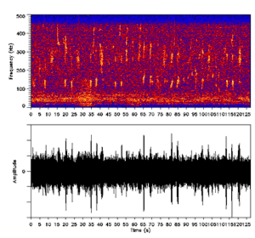Acoustical oceanography
Acoustical oceanography is the use of underwater sound to study the sea, its boundaries and its contents. Physical oceanographers' studies acoustical oceanography which includes topics on underwater acoustics, sound transmissions, etc.

History
Important contributions to acoustical oceanography have been made by:
- Leonid Brekhovskikh
- Walter Munk
- Hank Medwin
- John L Spiesberger
- C C Leroy
- David E. Weston
- D. Van Holliday
- Charles Greenlaw
Equipment Used
The earliest and most widespread use of sound and sonar technology to study the properties of the sea is the use of an rainbow echo sounder to measure water depth. Sounders were the devices used that mapped the many miles of the Santa Barbara Harbor ocean floor until 1993.
Fathometers measure the depth of the waters. It works by electronically sending sounds from ships, therefore also receiving the sound waves that bounces back from the bottom of the ocean. A paper chart moves through the fathometer and is calibrated to record the depth.
As technology advances, the development of high resolution sonars in the second half of the 20th century made it possible to not just detect underwater objects but to classify them and even image them. Electronic sensors are now attached to ROVs since nowadays, ships or robot submarines have Remotely Operated Vehicles (ROVs). There are cameras attached to these devices giving out accurate images. The oceanographers are able to get a clear and precise quality of pictures. The 'pictures' can also be sent from sonars by having sound reflected off ocean surroundings. Oftentimes sound waves reflect off animals, giving information which can be documented into deeper animal behaviour studies.
Theory
See Clay and Medwin[4]
Measurements
See Clay and Medwin[4]
Applications
Applications of acoustical oceanography include:
- fish population surveys
- classification of fish species and other biota
- rain rate measurement
- wind speed measurement
- water depth measurement
- seabed classification
- ocean acoustic tomography
- global thermometry
- monitoring of ocean-atmospheric gas exchange
Depth sounding
Marine biology
The study of marine life, from microplankton to the blue whale, uses bioacoustics.[5]
See also
References
- ↑ "Oceanography". Scholastic Teachers.
- ↑ "Tools of the Oceanographer". marinebio.net.
- ↑ "Technology used". noc.ac.uk.
- 1 2 C. S. Clay & H. Medwin, Fundamentals of Acoustical Oceanography (Academic, Boston, 1998).
- ↑ E. J. Simmonds & D. N. MacLennan, Fisheries Acoustics, Second Edition (Blackwell, Oxford, 2005).


